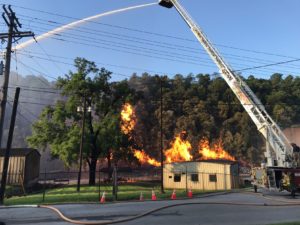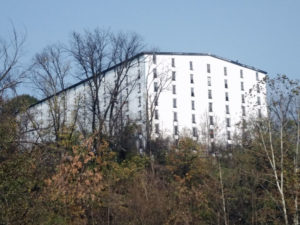With Small Accidents, Kentucky Is Getting Lucky
By Richard Thomas

(Credit: Kentucky Energy and Environment Cabinet)
Moreso than other recent accidents, the blaze that sent 45,000 barrels of Jim Beam whiskey up in smoke has made some in the enthusiast community anxious. While much of the social media commentary lamented the loss in general and sometimes satirical terms, substantial attention was given to the worry that the fire would prompt shortages and price increases. Some particularly well-informed bourbon-lovers posed the question of whether the fire might not cause Jim Beam to cancel the restoration of the 9 year age statement to Knob Creek, announced for mid-2020.
Jim Beam owns several complexes of warehouses across the state, with over 120 currently in full operation and holding some 3.3 million barrels, the largest store of aging whiskey in the Commonwealth. The day before Independence Day 2019, a fire on their Woodford County property damaged one warehouse and destroyed another, taking 45,000 barrels of whiskey with it. The property in question is in the vicinity of the Woodford Reserve and Castle & Key distilleries.
The Beam fire follows one year after Barton 1792, the Sazerac-owned distillery in Bardstown, suffered the unexpected collapse of one of its warehouses. Warehouse 30 was just shy of 80 years old, and like many old bourbon warehouses in Kentucky, was only in recent years being used to its full capacity for the first time in decades. No official statement regarding the cause or the extent of the damage to the 18,000 barrels stored in Warehouse 30 has yet been made, but the collapse could be explained either by aging timbers and/or weakening due to wood-eating pests, while it is estimated that between 1/3 and 1/2 of the barrels were destroyed.
This past month saw a similar warehouse collapse in Owensboro at the O.Z. Tyler Distillery. Owned by newcomer Teressentia, O.Z. Tyler isn’t making any popular or well-known brands as of yet, so the collapse attracted less attention (and fret). It was also not as severe a blow as the Barton collapse; out of 20,000 barrels stored in the building, some 4,000 were spilled from the building, and not all of those were damaged.
The Math
None of these accidents should be taken lightly by consumers, as they certainly are not by the liquor companies concerned. Given that a typical barrel of bourbon costs about $2,000 to make, the Beam fire consumed at least $90 million in inventory. Even with insurance, that is a hard pill to swallow. The loss from that single fire is in the same league as what Trump’s trade war is costing each of the big whiskey companies in terms of lost exports.

(Credit: Richard Thomas)
Yet a staggering number like that still needs to be viewed in the larger context of the industry. Beam Suntory has described the contents of the annihilated warehouse as youngish whiskey, and the contents of O.Z. Tyler’s fallen warehouse were undoubtedly also on the young side for the most part (any aged whiskey in Terressentia’s possession must have been sourced, and the company’s principal gimmick is allegedly accelerating the aging process using sonic techniques). Bourbon warehouses typically contain a mix of young, mature and aged whiskey in storage, and/or whiskeys of various types, as was known to be the case with the Barton warehouse, ensuring that accidents of this type cannot have an outsized impact on the company’s overall inventory.
What is more, none of these accidents have been big enough to seriously impact the larger inventory held by the company. The 45,000 barrels lost by Jim Beam on July 3 sound like a lot, but they represent a mere 0.013% of the company’s total stock. Although an expensive loss of capital investment, the loss is just a drop in Beam’s ocean of whiskey.
What A Real Catastrophe Looks Like
This is not to say that the bourbon industry couldn’t experience its own version of the Great San Francisco Earthquake, an event that would lay waste to a vast swathe of the industry and seriously impact consumers in immediate and painful ways. For an example of how that might transpire, look at the 1996 Heaven Hill fire and consider what would happen if such a thing happened today.
On November 7, 1996, a massive fire obliterated much of Heaven Hill’s Bardstown plant. * The main distillery and six entire warehouses were consumed by the blaze, with a seventh damaged, and those who were there still tell stories of rivers of burning whiskey flowing down the hillsides around the facility.
Some 90,000 barrels of whiskey were burned, with the total loss of equipment and stock running to $30 million. While that is only double what Beam lost in its fire earlier this month, 1996 was a very different time for the bourbon industry. Brown-Forman had only just opened the Woodford Reserve Distillery and Jim Beam’s Small Batch Collection (Knob Creek, Booker’s, Baker’s, Basil Hayden) was only a few years old. The original Pappy Van Winkle 20 Year Old (which was a rye-flavored, not wheated bourbon) had been introduced just two years before, and was readily available on store shelves at a quite reasonable price.
The bourbon business was only just beginning the revival that would lead to modern boom times. The 90,000 barrels lost in 1996 were therefore a much larger part of Heaven Hill’s stock than the 45,000 barrels burnt in Beam’s accident a couple of weeks ago. In the mid-1990s, the Kentucky bourbon industry was filling between 400,000 and 450,000 barrels every year; in 2017, the industry as a whole filled 1.7 million barrels, four times the 1990s average.
The timing of the 1996 disaster therefore meant Heaven Hill lost a larger proportion of its inventory, but at the same time the fact that the industry was only just emerging from its 1980s nadir held the keys to Heaven Hill’s recovery. If such a catastrophe struck any of Kentucky’s major distillers today, the aftermath could very well result in the demise of the company.
To this day, the way the Kentucky bourbon industry cooperated to help Heaven Hill get past its disaster remains a point of pride for just about everyone in it, something that even people who weren’t there speak of with emotion whenever the 1996 fire comes up. The rest of the business sold Heaven Hill stock to help them continue bottling their products. Shortly after the fire, the company that is now Diageo approached Heaven Hill about selling them the Bernheim distillery, a transaction that took place in 1999. Heaven Hill has since developed Bernheim into the largest single site bourbon distillery in America.
Imagine if Wild Turkey, Buffalo Trace or Barton (distilleries with the production plant and many of its warehouses clustered together on the same property) suffered a repeat of the 1996 fire. Because just about every bourbon warehouse in Kentucky is now filled to capacity (which wasn’t the case in the mid-1990s), the cost of having half a dozen such buildings go up in flames would be much higher. Replacing that lost stock would be impossible, because no combination of suppliers has a hundred thousand or more barrels of whiskey to sell or the contract time on their equipment to rent out so as to replace the lost production. Likewise, no one in the whiskey business has the slightest interest in selling a major, working distillery nowadays in the way Heaven Hill was able to acquire Bernheim.
In such a nightmare scenario, whether or not the company would survive would depend on their corporate parent. It’s easy to conceive a scenario where suffering such a loss after taking on tens of millions in debt to invest in expansions there would lead to the corporate parent deciding to wash their hands of the disaster, selling off the valuable brand and remaining stock rather than shovel more cash into a recovery. Certainly the surviving company would not be able to rebound in just a few years, as Heaven Hill did.
The truth is that accidents like the Barton Warehouse 30 collapse and the Beam’s Woodford County fire happen every few years in the industry. The only thing unusual in these incidents is that we’ve seen three of them in two years. A catastrophe on the scale of the Heaven Hill fire of 1996, however, is rarer. Only a handful of such events have ever taken place in the entire world whisk(e)y industry. In the modern boom times, when there is almost no slack to absorb the shock, such a disaster would truly have the kind of repercussions a consumer would feel at the liquor store.



